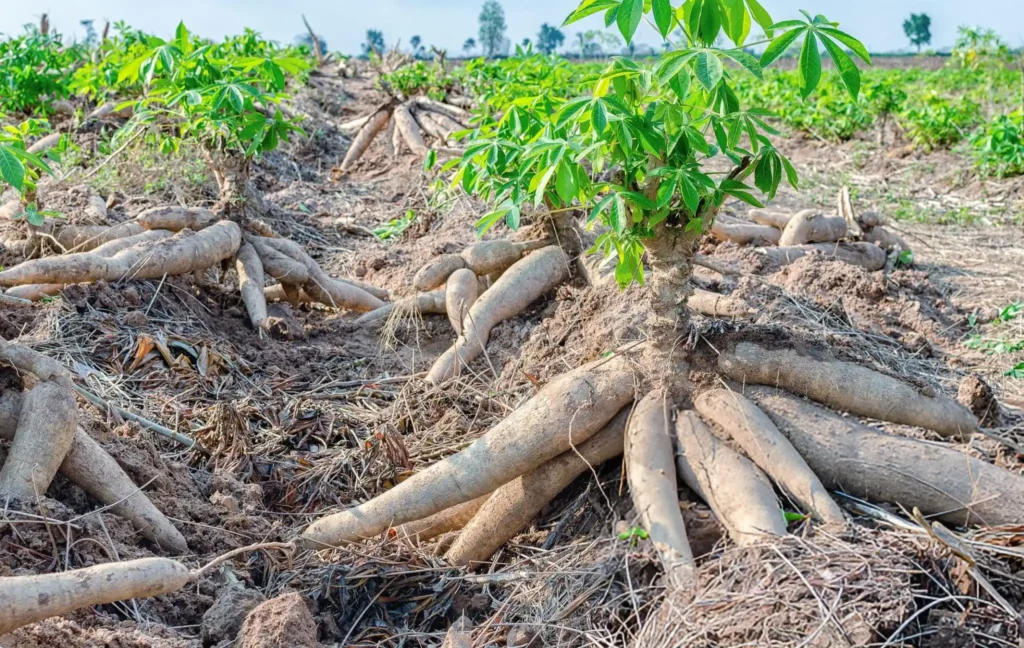1. Introduction: The Shift from Manual Labour to Mechanized Farming
Cassava farming is evolving fast. The days of using hoes and cutlasses are fading as more farmers adopt mechanized solutions that cut costs and boost yield.
In Nigeria, labour costs have risen by over 35% since 2022, while rainfall patterns have become more unpredictable. As a result, mechanization is no longer optional — it’s essential.
Whether you manage 1 hectare or 100, the right equipment can help you plant faster, harvest cleaner, and maximize every square meter of land.
2. Benefits of Using Modern Cassava Equipment
- Faster cultivation: Mechanization can reduce field work time by up to 70%.
- Higher yield: Proper tillage and planting spacing improve root formation.
- Lower labour costs: 3–5 workers can now do what used to take 20.
- Consistent quality: Uniform planting depth and soil preparation.
- Better post-harvest efficiency: Reduced waste, faster drying and packaging.
3. Essential Cassava Farming Equipment for 2025
Below are 9 must-have tools and machines for efficient cassava cultivation and processing this year.
1. Tractor and Tillage Equipment
Purpose: Land clearing, ploughing, harrowing, and ridging.
Details:
- Tractor models: Massey Ferguson 75hp or New Holland 70hp.
- Implements: Disc plough, harrow, and ridge maker.
Cost range: ₦6 million – ₦15 million.
Alternative: Rent via platforms like Hello Tractor (₦30,000 – ₦50,000/day).
2. Cassava Stem Planter
Purpose: Mechanized planting for uniform spacing and faster coverage.
Capacity: 4–6 rows per pass.
Output: Up to 4 hectares/day.
Cost: ₦1.5 million – ₦3 million.
Why it matters: Prevents human error and ensures 95% plant survival rate.
3. Fertilizer Applicator
Purpose: Delivers fertilizer evenly, improving nutrient efficiency.
Type: Tractor-mounted or handheld.
Cost: ₦100,000 – ₦500,000.
ROI: Reduces fertilizer waste by 25%.
4. Motorized Sprayer
Purpose: Protects against weeds, pests, and cassava mosaic disease.
Capacity: 16–20 litres, battery or petrol powered.
Cost: ₦45,000 – ₦120,000.
Tip: Use with recommended herbicides like Glyphosate or Atrazine.
5. Cassava Harvester
Purpose: Extracts tubers quickly and reduces breakage losses.
Types:
- Tractor-mounted harvesters: For large farms.
- Mini mechanical harvesters: For smallholders.
Cost: ₦1.5 million – ₦5 million.
Efficiency: 3–5× faster than manual harvesting.
6. Cassava Peeler
Purpose: Removes the outer skin efficiently before processing.
Capacity: 2–3 tons/day.
Cost: ₦600,000 – ₦1.2 million.
Why it matters: Saves time, reduces labour fatigue, improves hygiene.
7. Grater and Pressing Machine
Purpose: Converts cassava roots into mash and removes water content.
Used for: Garri, fufu, starch, and flour production.
Cost: ₦500,000 – ₦2 million (complete line).
Pro Tip: Stainless steel variants are more durable and food-safe.
8. Flash Dryer
Purpose: Rapidly dries cassava mash or flour while retaining nutrients.
Capacity: 250–1000 kg/hour.
Cost: ₦4 million – ₦8 million.
Market: Essential for HQCF and fufu flour producers targeting export.
9. Packaging and Sealing Machines
Purpose: For bagging garri, chips, and flour.
Cost: ₦300,000 – ₦1.5 million.
Benefit: Extends shelf life, improves brand appeal, and meets export standards.
4. Local Sources for Cassava Equipment in Nigeria
| Supplier | Location | Specialty |
|---|---|---|
| Niji Lukas Nigeria Ltd | Ibadan, Oyo State | Full cassava processing lines |
| IITA Mechanization Unit | Ibadan | Research-backed equipment |
| Proda Nigeria | Enugu | Affordable, small-scale tools |
| FarmTrac Africa | Lagos | Tractors and planting tools |
| Tanus Agro Partner Network | Nationwide | Verified local suppliers |
5. Financing and Leasing Options
Bank of Agriculture (BOA): Equipment loans up to ₦10 million.
- NIRSAL Equipment Leasing: Pay in installments over 12–24 months.
- Anchor Borrowers Program: Cooperative-based equipment access.
- Tanus Agro Co-op: Shared equipment model for smallholder farmers.
6. Tips for Maximizing Your Equipment Investment
- Train your workers before introducing new machinery.
- Schedule maintenance every 3 months to avoid breakdowns.
- Use genuine spare parts to extend equipment lifespan.
- Record usage hours — it helps in cost tracking and planning.
- Insure your machines (through NAIC or private providers).
7. Final Thoughts
Cassava mechanization is the gateway to profitability in modern agriculture. With the right tools, farmers can save time, cut labour costs, and multiply yield — all while building sustainable agribusinesses that feed Nigeria and beyond.
CTAWant help choosing or sourcing your cassava machinery? Contact Tanus Agro for verified suppliers, installation guidance, and training support.




